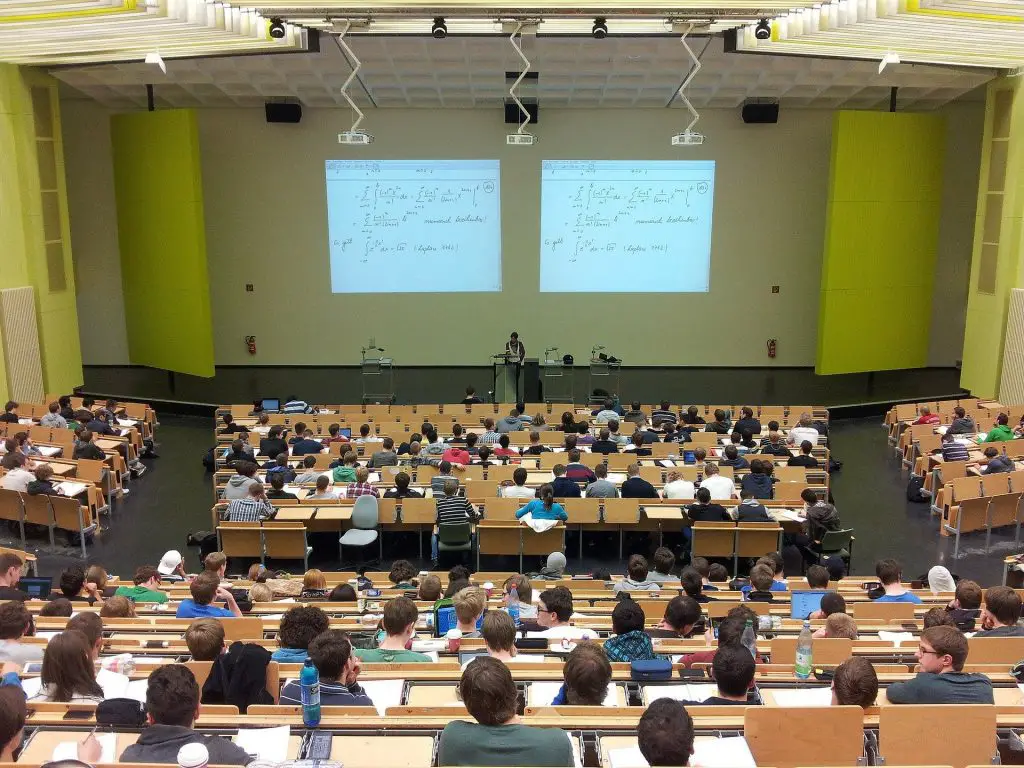This post contains affiliate links.
The transition from high school to college is an exciting time, but also one filled with many challenges. We researched the topics and consulted with university student services experts to demystify college classes and bring you the information you need to succeed.
Six Types of College Class Formats
College Lectures are the quintessential large college class with hundreds of students. The professor speaks and the students listen and take notes. With such a large format there is little opportunity for questions or interaction between the professor and students, questions are usually limited to a few minutes at the end of the lecture if time is allocated.

Large lecture classes with 200-300 students are common for general education courses taken during your first two years of college with a mandatory number of credit hours required. General education courses focus on critical thinking skills, acceptance of social diversity, and clear communication with the formation of logical arguments.
Expert Tip: You should expect any 100-level college course to include a lecture because of the large number of students required to take it for their degree program. Common general education classes include Psychology 101, English Literature, Basic Chemistry, College Algebra, Sociology 101, and Spanish 1.
College Discussion Sections (aka Recitations or Tutorials) are led by a teaching assistant (TA) and are a required part of lecture classes. While the entire class attends the same lecture, the discussion section will have a smaller group of 15-30 students. A normal 3 credit hour course will meet three times during a week, 2 sessions are lectures and the third is a discussion session.

With the smaller format, the discussion section allows for more in-depth dialogue and question-and-answer between the students and the TA. Teaching Assistants are normally graduate students working towards an advanced degree in the field. College essays/papers and problem assignments are handled through the discussion sessions and the TA will grade these items as well.
College Seminars become the norm as you progress into the 300 and 400 level courses. The large lecture hall format gives way to a more personal setting. Because these are upper-level courses they are more specialized and consequently have fewer students, typically 20-30.

Seminars still have the professor speaking for the duration of the class – and for this reason many universities still call them ‘lectures’ – but with fewer students there are more opportunities for asking questions and discussion of the advanced topics. Seminars are also paired with discussion sections and the discussion section may also be taught by the professor, but more commonly by TAs.
College Laboratory Classes are included with many lecture classes, most commonly in the sciences. The laboratory provides hands-on experience with the science rather than just reading and talking about concepts in class. Labs are about the practical application of knowledge and in many cases are a closer representation of actual career work.

Students attempt to take the material they’ve learned from the lecture and apply their knowledge in various lab experiments. Common examples of labs in college:
- Computer science labs where students write computer programs
- Astronomy labs where students apply observation techniques
- Biology labs where students complete dissections
- Chemistry labs where students mix chemical and perform experiments
- Physics labs where students demonstrate physical phenomena
- Psychology labs where students conduct surveys or conduct experiments on volunteers
- Medical labs where students observe procedures at a clinic

College labs are more involved than high school and require more independent thought. Where a high school chemistry lab just requires students to follow along and execute the procedure, a college chemistry lab may give each student an unknown substance that they must identify using the techniques they have learned.
College Studio Classes are most common in the Arts but the concept is spreading into other disciplines as well. Studio classes combine aspects of the college seminar and labs into a hands-on creative experience. A characteristic central to the studio class is teaching through example – the studio professor will give demonstrations, show slides, or give examples – and then the students will try their hand.

Studio classes are frequently much longer than other courses, sometimes meeting for three hours a day three times a week or even more. Students come to their designed workspace and work on their projects. At the end of each project, they have a formal review where professors, fellow students, and even guests will critique their work and give feedback.
Art studio classes spring to mind immediately as the classic example, but studio classes are also common in the performing arts, theater, music, design, and photography. But you can also find them in architecture, computer science, and engineering.

Studio courses are designed to encourage experimentation and allow students to learn from mistakes. They frequently collaborate with other students on projects and they build on their learning from one session to the next.
College Independent Study Classes are a custom option that typically requires you to consult with your faculty advisor to get approval. You effectively create your own course on a topic of your own choosing and work with a faculty advisor or another professor.
Independent study classes provide a way to earn college credit for special field experience or conducting your own research project. The independent study is self-paced and allows for greater flexibility than normal classwork, but the student also shoulders more responsibility. Students can schedule a meeting every 2-3 weeks with their advisor, but won’t be told what to do and will need to figure out most difficulties on their own.
Seven Categories of College Courses
General Education Courses, also known as core curriculum, are courses designed to produce graduates that are well-rounded. Engineering majors are required to complete a number of credit hours in the Humanities and English majors are required to complete credit hours in math and science.
Expert Tip: Many universities have a “breadth and depth” requirement that is 32-40 credit hours of coursework that teach basic science, economics, foreign language or cultural studies, history, and writing.
Students must complete courses from all four disciplines of Humanities, Social Sciences, Pure Sciences, and Applied Sciences, and complete at least one 300-level course from a discipline outside your major.
Major Courses contribute to the credit hours required for your major degree program.
Mandatory Courses are required classes that you must complete in order to satisfy your degree program. These are core courses in the specialization that everyone is required to take.
Minor Courses contribute to the credit hours required for your minor degree program. Academic minors are associated with undergraduate degrees and highly dependent on the school you attend. Some universities require minors in certain degree programs.
Elective Courses are optional classes that you can choose to take, usually outside your field of interest and not required for your degree program. Many students use the classes as a form of stress relief and to socialize, while others will choose their electives to work towards a concentration in a specific area.
Prerequisite Courses, usually shortened to prereq, are required classes that you must complete before you are allowed to enroll in another class. For example, Math 102 lists Math 101 as a prereq because you must have the Math 101 skills to succeed in Math 102.
Weed-Out Courses are not listed in the university catalog but they are intentional. Within each major, there are at least one, sometimes two, courses that are notoriously challenging for students to complete.
Normally they are mandatory 300-level courses within the major. Because every student is required to complete them successfully, they are set up to test the student’s capability and resolve in their chosen field. Because they are early in the coursework for the major the student can still switch majors with relatively little impact on their graduation schedule.
Additional terms used when describing college courses with definitions you need to know:
- 100 level courses – These are basic courses typically taken by first-year students and usually with no prerequisites.
- 200 level courses – These are intermediate courses commonly taken by second-year students, they may have prereqs but are usually open to students from other majors.
- 300 level courses – These are upper-division courses normally taken by third-year students and have 200-level courses as prereqs; 300-level courses are frequently restricted to students accepted into the degree program for that college or school.
- 400 level course – These are advanced-level courses taken in the final year before earning a Bachelor degree and have 300-level courses as prereqs.
- 500, 600, 700, 800 and higher-level courses – These are graduate-level courses normally reserved for students enrolled in their Masters or Ph.D. program; undergrad students frequently require faculty approval to enroll.
The terms underclassmen and upperclassmen are falling out of use because they are less socially acceptable. Similarly the terms first-year, second-year, etc… are less applicable because student may start their college careers with several AP credits and internships throw off the traditional 4-year completion schedule.
You will also hear some people use upper-level and lower-level as the general terms, but most people simply refer to the course by its number level.
Is There Homework in College?
College students don’t use the term ‘homework’ but they are very busy doing work outside of the time they spend in class. College students will call is ‘studying’ but the meaning is the same – their job is to do homework for class.

All courses will have assigned reading and studying required to learn the material. Humanities courses frequently have essays and debates to prepare, STEM courses assign problem sets that need to be worked. Term papers and design projects are also common in upper-level courses.
Sometimes the TAs will not even collect the assignments or check them, but they usually don’t announce it in advance so that students still do the work.
What Does ‘Credit Hours’ Mean?
In the U.S., college classes are 1 hour per week per credit, this is why they are also called “credit hours”. For each credit hour you take, expect to spend 1 hour per week in the classroom and a minimum of 2 hours per week studying outside of class.
| College Class | Classroom Time | Study Time |
|---|---|---|
| 1 credit hour | 1 hour | 2 hours |
| 2 credit hours | 2 hours | 4 hours |
| 3 credit hours | 3 hours | 6 hours |
| 4 credit hours | 4 hours | 8 hours |
| 5 credit hours | 5 hours | 10 hours |
For a typical full-time student taking 15 credit hours per semester, this means they spend 15 hours per week in class and are expected to spend at least 30 hours per week outside of class to study and complete assignments.
Each area of study will have its own set of challenges. For example, engineering courses are notorious for assigning difficult problem sets that may take significantly longer to complete. Pre-law students should expect to have many assignments with large required reading and essay responses.
The credit hour, also known as the Carnegie Unit, originated in 1909 from Andrew Carnegie as part of his philanthropic efforts to establish a retirement fund for “one of the poorest paid
but highest professions in our nation”—college professors. The Carnegie Unit: A Century-Old Standard in a Changing Education Landscape
How Long Are College Classes?
College classes use a block schedule that meets for a 50 min session with a 10 minute passing period. However, there are other common combinations of class length and frequency. For example, a normal 3 credit hour class that meets 3 times per week will last for 50-minutes each session. They may offer the same class with a schedule that meets 2 times per week for 75-minutes each, or even 1 time per week for 150-minutes.

Here are typical combinations of college class meeting frequency and class duration:
| College Class | 1 Time per Week | 2 Times per Week | 3 Times per Week | 4 Times per Week | 5 Times per Week |
|---|---|---|---|---|---|
| 1 credit hour | 50 min | — | — | — | — |
| 2 credit hours | 100 min | 50 min | — | — | — |
| 3 credit hours | 150 min | 75 min | 50 min | — | — |
| 4 credit hours | — | 100 min | — | 50 min | — |
| 5 credit hours | — | 150 min | — | — | 50 min |
College labs normally have double the number of classroom time compared to a lecture for the same credit hours. This is because the student does most of the work in the lab, with less time spent outside of class preparing and writing the lab report. So a 1 credit hour lecture will meet for 50 minutes each week, while a 1 credit hour lab will meet for 100 minutes each week.
Some universities bundle their lectures and labs together under the same course number – i.e. a Chemistry 101 is a 3 credit hour lecture and 2 credit hour lab (5 credit hours total) – while other universities separate the lab and lecture into separate class numbers. In both cases, you are required to complete the lecture and lab during the same semester.
How Do College Schedules Work?
Unlike in high school where there was a set bell schedule and everyone had classes during the same seven hours each day, college classes have a wide variety in their schedule. Classes are offered in the morning, afternoon, evening, and late into the night to accommodate different schedules. Some universities offer night school programs designed for people who work a regular day shift and want to continue their education.
Do You Have Classes Every Day In College? At college you have the flexibility to schedule your week tailored to your preferences and needs. Most students will design their schedules with classes every day in order to balance out their workload. Some students design their schedules with classes only in the mornings so they can work the afternoon at their job.
Crafting the perfect college schedule is a top priority for many college students. It can be a thing of beauty when you are able to avoid early morning classes and have nothing scheduled on Friday. Who doesn’t love sleeping in and long weekends?
How Many Classes Do College Students Take a Day? With a perfectly balanced schedule a typical college student will have four classes each day, but this rarely happens. More common is to have some days with three classes and some days with five classes with classes that meet infrequently, like labs, sprinkled in where they fit.
Ultimately you will need to select your class schedule based on section availability and conflicts with other classes. Unlike in high school where your schedule was provided to you, in college you have to find your own solution. Sometimes the only option is to take that class at the time you don’t want and with the more difficult professor in order to stay on track for graduation.
How Many Classes Should I Take Per Semester in College?
Full-Time Students are required to take a minimum of 12 credit hours each semester, up to a maximum of 18 credit hours. Most students take 15-16 credit hours per semester to stay on track for graduation.
Bachelor degrees require at least 120 credits for completion. This equates to 15 credit hours per semester (4 years x 2 semesters x 15 credits = 120) or about 40 courses on average. However, this requires students to only select courses that count toward their degree program in order to stay on track.
Exploring new fields is part of the reason for going to college and many students also include ‘fun’ electives, this is part of why only 41.6% of students graduate within 4 years. Changing majors will also delay graduation because of lost credits from already completed courses that do not count towards your new degree program.
How Many Classes Should I Take My First Semester of College? Your first semester of college is an enormous transition. You are moving away from home and living on your own for the first time, in a new city, and with many new responsibilities. You want to allow time for socializing and exploring all that your university has to offer while also succeeding academically.
Your first semester of college should include at least 12 credit hours of your core classes that are required for your degree plan and an additional 3-4 credits of electives. Use the electives to jump-start your network of friends and explore opportunities that were not available in high school.
The first semester can be a difficult transition, your college professors have much higher expectations and will not hand-hold students like in high school. It is common for most students to see their average grade drop a full level from high school. Don’t overload with 16 credits of intense coursework in your first semester, give yourself time to adjust.
You are expected to manage yourself and get your work done, after all, you are paying for the privilege of going to college so you need to take ownership of your own education.
How Long is a Semester of College?
College semesters during the spring and fall last for 16 weeks. There are accelerated summer courses that meet for 8-9 weeks during the summer months that will meet more frequently and/or for a longer duration to complete the same amount of instruction in the shorter time period.
What Are College Office Hours?
Both professors and TAs will hold office hours when they are available to meet individually with students outside of regular class times. TA office hours are used to help with problem assignments while office hours with the professors are used to clarify concepts from the lectures.

